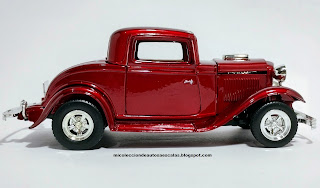Este es un blog de fotografías para la colección personal de autos de diferentes escalas.
Sunday, January 21, 2024
1999 Chrysler Howler Motormax 1:24
Sunday, January 14, 2024
1949 Ford Coupe Police Motormax 1:24
Sunday, January 7, 2024
1932 Ford Coupe Custom Motor Max 1:24
Thursday, December 28, 2023
Forklift Montacargas XLC ALLOY TOY 1:50 Fragile
La función primaria de un montacargas es de levantar, bajar, y mover cargas con muy poco, o sin ningún tipo de esfuerzo manual. Esto es posible usando un mástil en la parte de enfrente de una grúa horquilla.
Se define como un equipo móvil de contrapeso, ya que la carga que manipula está fuera de la distancia entre sus ejes. Los montacargas contrabalanceadas se basan en los principios de balance y estabilidad. En la línea central del eje de transmisión se encuentra el punto de equilibrio.
El montacargas tiene dos barras paralelas planas en su parte frontal que se introducen en el palé (debajo de la carga), llamadas «horquillas» (a veces, coloquialmente también «uñas»), montadas sobre un soporte que se desliza verticalmente por un mástil con lo que se consigue el movimiento de elevación y descenso de la carga. La separación entre horquillas es variable para adaptarse a distintas medidas de palé o cargas; el soporte de las horquillas disfruta de un pequeño desplazamiento lateral (a derecha e izquierda) para realizar maniobras de aproximación del palé o el centrado de las uñas con la carga.
Las ruedas traseras de los montacargas son orientables (directrices) con un gran ángulo de giro para facilitar la maniobrabilidad en espacios angostos. Habitualmente las ruedas delanteras son las motrices o propulsoras; también hay versiones 4x4 para su uso en exteriores o en obras de construcción.
La elevación de las horquillas, así como la inclinación del mástil y otros movimientos se realizan a través de pistones hidráulicos que forman parte de un sistema óleo-hidráulico accionado por una bomba a la que suministra energía el mismo motor utilizado para el desplazamiento en las de motor térmico y generalmente por un motor aparte en el caso de las eléctricas.
Es de uso rudo e industrial, y se utiliza en almacenes, complejos fabriles, centros logísticos y tiendas de autoservicio para transportar y sostener tarimas o palés con mercancías y acomodarlas en estanterías o racks y realizar las actividades de carga y descarga de camiones o contenedores.
Aguanta cargas pesadas que ningún grupo de personas podría soportar por sí misma, y ahorra horas de trabajo pues se traslada un peso considerable de una sola vez en lugar de ir dividiendo el contenido de las tarimas por partes o secciones. Su uso requiere una cierta capacitación y los gobiernos de distintos países exigen a los negocios que sus empleados tramiten licencias especiales para su manejo. Requieren además neumáticos especiales a prueba de pinchazos.



























































